Shuttle Endeavour glides to smooth Florida touchdown (UPDATED)
06/01/2011 04:33 AM Filed in: STS-134 | STS-135 | Space News | Space Shuttle | International Space Station
Editor's note...
CBS News
KENNEDY SPACE CENTER, FL--Signaling the beginning of the end for NASA's storied shuttle program, the Endeavour plunged back to Earth Wednesday, closing out its 25th and final flight and passing the baton to its sistership Atlantis, which was hauled to the launching pad a few hours earlier for blastoff July 8 on the program's final voyage.
With commander Mark Kelly and pilot Gregory Johnson at the controls, Endeavour dropped out of a moonless sky and into the glare of powerful xenon floodlights after a fiery descent from orbit, settling to a ghostly touchdown on runway 15 at 2:34:51 a.m. EDT (GMT-4).
Barreling down the 300-foot-wide landing strip at more than 200 mph, Johnson deployed a large red-and-white braking parachute, Kelly brought the nose down and Endeavour coasted to a stop on the runway centerline.
"Houston, Endeavour. Wheels stopped," Kelly radioed in a traditional call to Houston.
"One-hundred-twenty-two-million miles flown during 25 challenging space flights, your landing ends a vibrant legacy for this amazing vehicle that will long be remembered," astronaut Barry "Butch" Wilmore replied from mission control. "Welcome home, Endeavour."
"Thank you, Houston," Kelly said. "You know, the space shuttle is an amazing vehicle, to fly through the atmosphere, hit it at Mach 25, steer through the atmosphere like an airplane, land on a runway, it is really, really an incredible ship.
"On behalf of my entire crew, I want to thank every person who's worked to get this mission going and every person who's worked on Endeavour. It's sad to see her land for the last time, but she really has a great legacy."
While engineers and technicians swarmed around the orbiter for post-flight "safing," Kelly, Johnson, European Space Agency flight engineer Roberto Vittori and spacewalkers Michael Fincke, Gregory Chamitoff and Andrew Feustel doffed their pressure suits and joined senior NASA managers on the runway for a traditional walk-around inspection before departing for crew quarters and reunions with friends and family.
Before leaving the orbiter, Johnson shut down the ship's three hydraulic power units and a moment later, their fiery exhaust plumes flickered out for the last time, a poignant reminder Endeavour's flying days were over.
During the course of Endeavour's 16-day mission, Kelly and his crewmates attached a $2 billion cosmic ray detector to the International Space Station, installed a pallet of spare components, staged four spacewalks to conduct needed maintenance and helped the station crew repair a U.S. oxygen generator and a carbon dioxide scrubber.
Mission duration was 15 days 17 hours 38 minutes and 23 seconds, a voyage spanning 248 complete orbits and 6.5 million miles since blastoff May 16. Over the course of its 25-mission career, Endeavour logged 122,853,853 million miles, 4,671 orbits and 299 days in space, carrying the first and last U.S. components to the International Space Station.
A few miles from the shuttle runway, a powerful Apollo-era crawler-transporter was slowly moving Atlantis into position atop pad 39A after a six-hour 3.4-mile trip from NASA's Vehicle Assembly Building.
A throng of space center workers, many of them facing layoffs after Atlantis' flight, turned out to witness the last shuttle "rollout," cheering as the shuttle emerged into the light of powerful floodlights around 8:45 p.m. Tuesday. Atlantis' crew -- commander Christopher Ferguson, pilot Douglas Hurley, Rex Walheim and Sandra Magnus -- mingled with the crowd and chatted with reporters about the looming end of the shuttle program.
"You can't watch that vehicle roll by without thinking what an amazing achievement America has, that America can build something like that, put people inside and sling them off this Earth into space. It's absolutely amazing."
With Atlantis on its way to the pad, Kelly and his crewmates closed Endeavour's 60-foot-long payload bay doors at 10:45 p.m. Two hours and 45 minutes later, at 1:29:03 a.m., Kelly and Johnson carried out a two-minute 38-second firing of the shuttle's orbital maneuvering system rockets, slowing the ship by about 201 mph to drop it out of orbit for an hourlong glide back to Florida.
After a half-hour free fall, Endeavour plunged into the discernible atmosphere at an altitude of about 76 miles. A few minutes later, the orbiter entered the zone of peak heating, experiencing temperatures of more than 3,000 degrees Fahrenheit on its reinforced carbon carbon nose cap and wing leading edge panels.
Approaching Florida from the southwest, Endeavour streaked high above the Yucatan Peninsula, across the Gulf of Mexico and then over the west coast of Florida above Naples, descending steeply toward the Kennedy Space Center.
Taking over manual control at an altitude of about 50,000 feet, Kelly guided Endeavour through a sweeping 245-degree left overhead turn to line up on runway 15, settling to a tire-smoking touchdown a few moments later.
Over the next few months, Endeavour, like the shuttle Discovery before it, will be decommissioned and prepared for museum display.
Discovery, which completed its last flight in March, is going to the Smithsonian National Air and Space Museum's Steven F. Udvar-Hazy Center near Washington while Endeavour is bound for the Los Angeles Science Center. Atlantis will remain in Florida and go on display at the Kennedy Space Center's visitors complex.
Engineers plan to load Atlantis' external tank with super cold propellants June 15 to make sure suspect rib-like stringers can withstand the rigors of fueling and launch. The stringers were beefed up in the wake of cracks found in a tank used by Discovery earlier this year and engineers do not expect any problems. But the fueling test was ordered to make sure.
If all goes well, Ferguson and his three crewmates will blast off at 11:38 a.m. on July 8 and dock with the International Space Station two days later.
The primary goal of the flight is to deliver critical supplies as a hedge against problems that might delay commercial cargo ships being developed to fill in for the shuttle after the fleet is retired. Combined with deliveries by Russian and European cargo ships, Atlantis will carry enough supplies to support the station's six-person crew through 2012.
Atlantis originally was intended to serve as a launch-on-need emergency rescue vehicle in case Endeavour's crew ran into problems that might prevent a safe reentry. But NASA managers ultimately decided to use the agency's final set of boosters and its last external tank to launch one last space station resupply mission.
To get around the need for a stand-by rescue shuttle, NASA decided to limit Atlantis' crew to four. If Atlantis runs into a major problem, Ferguson, Hurley, Walheim and Magnus will be able to rotate home aboard Russian Soyuz spacecraft, a slow-motion "rescue" that would take a full year to complete.
But Ferguson and his crew believe the shuttle workforce will do everything possible to make sure the program ends on a high note.
"This is a tried and true group of professionals and it has been nothing but ultra impressive to see a lot of people who are clearly at a crossroads in their lives ... stay so focused and motivated on the final mission," Ferguson said.
"They clearly have a vested interest in making sure that this mission goes off as successful as we do. I've seen absolutely no indication of any ill feelings toward NASA, toward the country. I think they're just elated to have been a part of this program for 30 years."
- Posted at 03:10 AM EDT, 06/01/11: Shuttle Endeavour glides to smooth Florida touchdown
- Updated at 04:35 AM EDT, 06/01/11: Adding photos
CBS News
KENNEDY SPACE CENTER, FL--Signaling the beginning of the end for NASA's storied shuttle program, the Endeavour plunged back to Earth Wednesday, closing out its 25th and final flight and passing the baton to its sistership Atlantis, which was hauled to the launching pad a few hours earlier for blastoff July 8 on the program's final voyage.
With commander Mark Kelly and pilot Gregory Johnson at the controls, Endeavour dropped out of a moonless sky and into the glare of powerful xenon floodlights after a fiery descent from orbit, settling to a ghostly touchdown on runway 15 at 2:34:51 a.m. EDT (GMT-4).
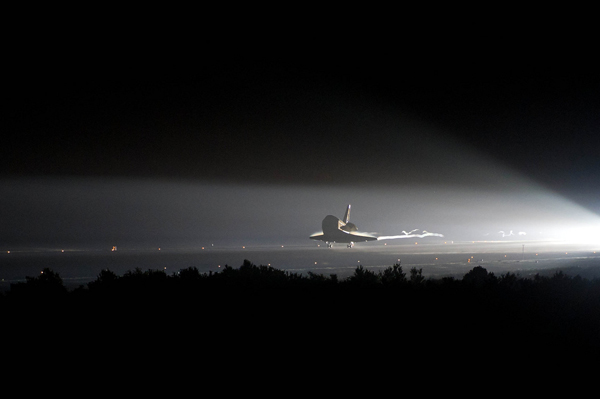 |
| The shuttle Endeavour swoops to a ghostly night landing to close out its 25th and final flight. (Credit: Bill Ingalls/NASA) |
Barreling down the 300-foot-wide landing strip at more than 200 mph, Johnson deployed a large red-and-white braking parachute, Kelly brought the nose down and Endeavour coasted to a stop on the runway centerline.
"Houston, Endeavour. Wheels stopped," Kelly radioed in a traditional call to Houston.
"One-hundred-twenty-two-million miles flown during 25 challenging space flights, your landing ends a vibrant legacy for this amazing vehicle that will long be remembered," astronaut Barry "Butch" Wilmore replied from mission control. "Welcome home, Endeavour."
"Thank you, Houston," Kelly said. "You know, the space shuttle is an amazing vehicle, to fly through the atmosphere, hit it at Mach 25, steer through the atmosphere like an airplane, land on a runway, it is really, really an incredible ship.
"On behalf of my entire crew, I want to thank every person who's worked to get this mission going and every person who's worked on Endeavour. It's sad to see her land for the last time, but she really has a great legacy."
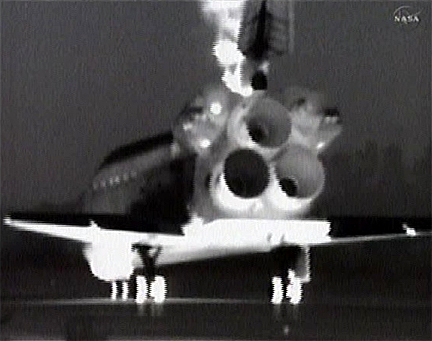 |
| An infrared view of Endeavour on the runway, the exhaust from its hydraulic power system flaring beside the ship's tail fin. (Credit: NASA TV) |
Before leaving the orbiter, Johnson shut down the ship's three hydraulic power units and a moment later, their fiery exhaust plumes flickered out for the last time, a poignant reminder Endeavour's flying days were over.
During the course of Endeavour's 16-day mission, Kelly and his crewmates attached a $2 billion cosmic ray detector to the International Space Station, installed a pallet of spare components, staged four spacewalks to conduct needed maintenance and helped the station crew repair a U.S. oxygen generator and a carbon dioxide scrubber.
Mission duration was 15 days 17 hours 38 minutes and 23 seconds, a voyage spanning 248 complete orbits and 6.5 million miles since blastoff May 16. Over the course of its 25-mission career, Endeavour logged 122,853,853 million miles, 4,671 orbits and 299 days in space, carrying the first and last U.S. components to the International Space Station.
A few miles from the shuttle runway, a powerful Apollo-era crawler-transporter was slowly moving Atlantis into position atop pad 39A after a six-hour 3.4-mile trip from NASA's Vehicle Assembly Building.
A throng of space center workers, many of them facing layoffs after Atlantis' flight, turned out to witness the last shuttle "rollout," cheering as the shuttle emerged into the light of powerful floodlights around 8:45 p.m. Tuesday. Atlantis' crew -- commander Christopher Ferguson, pilot Douglas Hurley, Rex Walheim and Sandra Magnus -- mingled with the crowd and chatted with reporters about the looming end of the shuttle program.
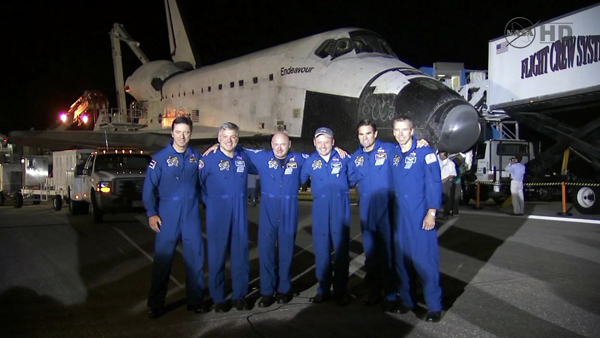 |
| The shuttle Endeavour's crew on the runway after landing. Left to right: Roberto Vittori, pilot Gregory Johnson, commander Mark Kelly, Michael Fincke, Gregory Chamitoff and Andrew Feustel. (Credit: NASA TV) |
"You can't watch that vehicle roll by without thinking what an amazing achievement America has, that America can build something like that, put people inside and sling them off this Earth into space. It's absolutely amazing."
With Atlantis on its way to the pad, Kelly and his crewmates closed Endeavour's 60-foot-long payload bay doors at 10:45 p.m. Two hours and 45 minutes later, at 1:29:03 a.m., Kelly and Johnson carried out a two-minute 38-second firing of the shuttle's orbital maneuvering system rockets, slowing the ship by about 201 mph to drop it out of orbit for an hourlong glide back to Florida.
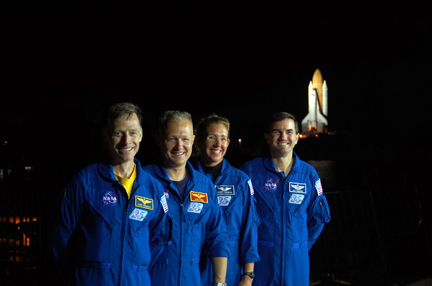 |
| The "final four" shuttle astronauts (left to right): Atlantis commander Christopher Ferguson, pilot Douglas Hurley, Sandra Magnus and Rex Walheim. (Credit: William Harwood/CBS News) |
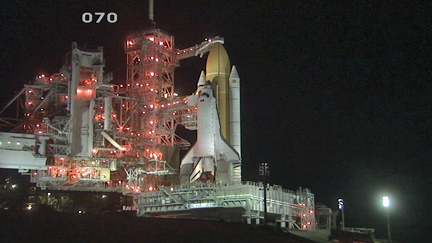 |
| The shuttle Atlantis atop pad 39A early Wednesday after an overnight trip from NASA's Vehicle Assembly Building. Launch on NASA's final shuttle flight is targeted for July 8. (Credit: NASA TV) |
Taking over manual control at an altitude of about 50,000 feet, Kelly guided Endeavour through a sweeping 245-degree left overhead turn to line up on runway 15, settling to a tire-smoking touchdown a few moments later.
Over the next few months, Endeavour, like the shuttle Discovery before it, will be decommissioned and prepared for museum display.
Discovery, which completed its last flight in March, is going to the Smithsonian National Air and Space Museum's Steven F. Udvar-Hazy Center near Washington while Endeavour is bound for the Los Angeles Science Center. Atlantis will remain in Florida and go on display at the Kennedy Space Center's visitors complex.
Engineers plan to load Atlantis' external tank with super cold propellants June 15 to make sure suspect rib-like stringers can withstand the rigors of fueling and launch. The stringers were beefed up in the wake of cracks found in a tank used by Discovery earlier this year and engineers do not expect any problems. But the fueling test was ordered to make sure.
If all goes well, Ferguson and his three crewmates will blast off at 11:38 a.m. on July 8 and dock with the International Space Station two days later.
The primary goal of the flight is to deliver critical supplies as a hedge against problems that might delay commercial cargo ships being developed to fill in for the shuttle after the fleet is retired. Combined with deliveries by Russian and European cargo ships, Atlantis will carry enough supplies to support the station's six-person crew through 2012.
Atlantis originally was intended to serve as a launch-on-need emergency rescue vehicle in case Endeavour's crew ran into problems that might prevent a safe reentry. But NASA managers ultimately decided to use the agency's final set of boosters and its last external tank to launch one last space station resupply mission.
To get around the need for a stand-by rescue shuttle, NASA decided to limit Atlantis' crew to four. If Atlantis runs into a major problem, Ferguson, Hurley, Walheim and Magnus will be able to rotate home aboard Russian Soyuz spacecraft, a slow-motion "rescue" that would take a full year to complete.
But Ferguson and his crew believe the shuttle workforce will do everything possible to make sure the program ends on a high note.
"This is a tried and true group of professionals and it has been nothing but ultra impressive to see a lot of people who are clearly at a crossroads in their lives ... stay so focused and motivated on the final mission," Ferguson said.
"They clearly have a vested interest in making sure that this mission goes off as successful as we do. I've seen absolutely no indication of any ill feelings toward NASA, toward the country. I think they're just elated to have been a part of this program for 30 years."